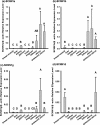The sodium channel gene family is specifically expressed in hen uterus and associated with eggshell quality traits
- PMID: 24059973
- PMCID: PMC3851161
- DOI: 10.1186/1471-2156-14-90
The sodium channel gene family is specifically expressed in hen uterus and associated with eggshell quality traits
Abstract
Background: Eggshell quality is important for the poultry industry. During eggshell formation a mass of inorganic minerals is deposited. The Sodium Channel (SCNN1) gene family plays an essential role in cation transportation. The objective of this study was to investigate the pattern of expression of members of the SCNN1 gene family, their variation and their effects on eggshell quality.
Result: The highest expression of SCNN1a, SCNN1b, and SCNN1g genes were in the active uterus during eggshell mineralization, while SCNN1d showed its highest expression level in the quiescent uterus (no egg present). Nineteen candidate SNPs from the four genes were genotyped in a population of 338 White Leghorn layers. Association analysis between SNPs (haplotypes/diplotypes) and eggshell traits was performed. Among seven significant SNPs, five SNPs were associated with eggshell strength, eggshell thickness, eggshell percentage or/and egg weight, while the other two SNPs within SCNN1d were only associated with eggshell percentage. These SNPs had a 0.25-6.99% contribution to phenotypic variance, depending on the trait. In haplotype analysis, SCNN1b and SCNN1d were associated with egg weight. The SCNN1b and SCNN1g were significantly associated with eggshell weight while only SCNN1g explained 2.04% of phenotypic variance. All the alleles of the members of SCNN1 gene family were associated with eggshell percentage and eggshell thickness, and others members had an association with eggshell strength except for SCNN1a. The contribution of different haplotypes of the SCNN1 gene family to eggshell phenotypic variance ranged from 0.09% to 5.74%.
Conclusions: Our study indicated that the SCNN1 gene family showed tissue expression specificity and was significantly associated with eggshell traits in chicken. This study provides evidence that genetic variation in members of the sodium channel can influence eggshell quality.
Figures


Similar articles
-
Effect of heat stress on the gene expression of ion transporters/channels in the uterus of laying hens during eggshell formation.Stress. 2018 Jan;21(1):51-58. doi: 10.1080/10253890.2017.1394291. Epub 2017 Nov 8. Stress. 2018. PMID: 29115887
-
Polymorphisms in Ion Transport Genes Are Associated with Eggshell Mechanical Property.PLoS One. 2015 Jun 24;10(6):e0130160. doi: 10.1371/journal.pone.0130160. eCollection 2015. PLoS One. 2015. PMID: 26106883 Free PMC article.
-
Variation in the ovocalyxin-32 gene in commercial egg-laying chickens and its relationship with egg production and egg quality traits.Anim Genet. 2012 Jul;43 Suppl 1:102-13. doi: 10.1111/j.1365-2052.2012.02384.x. Anim Genet. 2012. PMID: 22742508
-
Genome-wide association study and a post replication analysis revealed a promising genomic region and candidate genes for chicken eggshell blueness.PLoS One. 2019 Jan 23;14(1):e0209181. doi: 10.1371/journal.pone.0209181. eCollection 2019. PLoS One. 2019. PMID: 30673708 Free PMC article.
-
Protein constituents of the eggshell: eggshell-specific matrix proteins.Cell Mol Life Sci. 2009 Aug;66(16):2707-19. doi: 10.1007/s00018-009-0046-y. Epub 2009 May 19. Cell Mol Life Sci. 2009. PMID: 19452125 Free PMC article. Review.
Cited by
-
Genetic architecture dissection by genome-wide association analysis reveals avian eggshell ultrastructure traits.Sci Rep. 2016 Jul 26;6:28836. doi: 10.1038/srep28836. Sci Rep. 2016. PMID: 27456605 Free PMC article.
-
Identifying artificial selection signals in the chicken genome.PLoS One. 2018 Apr 26;13(4):e0196215. doi: 10.1371/journal.pone.0196215. eCollection 2018. PLoS One. 2018. PMID: 29698423 Free PMC article.
-
Effects of Growth-Related Genes on Body Measurement Traits in Wenshang Barred Chickens.J Poult Sci. 2022 Oct 25;59(4):323-327. doi: 10.2141/jpsa.0210138. J Poult Sci. 2022. PMID: 36382061 Free PMC article.
-
Inactivation of epithelial sodium ion channel molecules serves as effective diagnostic biomarkers in clear cell renal cell carcinoma.Genes Genomics. 2023 Jul;45(7):855-866. doi: 10.1007/s13258-023-01376-8. Epub 2023 May 3. Genes Genomics. 2023. PMID: 37133722
-
Proteomic analysis of quail calcified eggshell matrix: a comparison to chicken and turkey eggshell proteomes.Proteome Sci. 2015 Aug 27;13:22. doi: 10.1186/s12953-015-0078-1. eCollection 2015. Proteome Sci. 2015. PMID: 26312056 Free PMC article.
References
-
- Nys Y, Bain M, Immerseel FV. Improving the safety and quality of eggs and egg products. Oxford: Woodhead Pub; 2011.
-
- Takahashi H, Yang D, Sasaki O, Furukawa T, Nirasawa K. Mapping of quantitative trait loci affecting eggshell quality on chromosome 9 in an F2 intercross between two chicken lines divergently selected for eggshell strength. Anim Genet. 2009;40(5):779–782. doi: 10.1111/j.1365-2052.2009.01914.x. - DOI - PubMed
-
- Romanoff AL. Study of the Physical Properties of the Hen's Eggshell in Relation to the Function of Shell-Secretory Glands. Biol Bull. 1929;56(5):351–356. doi: 10.2307/1537075. - DOI
-
- Nys Y, Gautron J, Garcia-Ruiz JM, Hincke MT. Avian eggshell mineralization: biochemical and functional characterization of matrix proteins. Comptes Rendus Palevol. 2004;3(6–7):549–562.
Publication types
MeSH terms
Substances
LinkOut - more resources
Full Text Sources
Other Literature Sources

